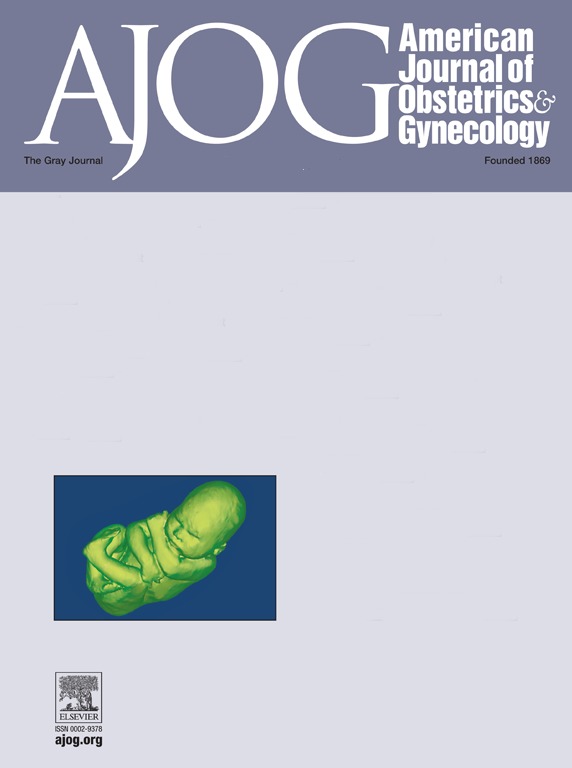阴道分娩后1年阴道裂孔增大与膀胱过度活动引起的脱垂的关系。
IF 8.7
1区 医学
Q1 OBSTETRICS & GYNECOLOGY
引用次数: 0
摘要
背景生殖器裂孔增大与盆腔器官脱垂和首次分娩后 5-10 年的膀胱过度活动有关。研究设计这是一项前瞻性队列研究的二次分析,研究对象是经阴道分娩的单胎初产妇,她们在妊娠三个月、产后 8 周和产后 1 年分别完成了症状问卷调查和体格检查。我们将膀胱过度活动症定义为出现尿急、尿频或夜尿,或尿失禁流行病学问卷调查中的尿急尿失禁。生殖器裂隙增大 > 4 厘米,解剖学上的盆腔器官脱垂是指阴道下降到处女膜或超过处女膜。我们使用泊松回归法评估了膀胱过度活动症与生殖器裂孔和产后 1 年盆腔器官脱垂的相关性。在不同的模型中,产后 1 年时生殖器裂孔增大和解剖学上的盆腔器官脱垂分别与产后 1 年时膀胱过度活动症患病率增加有关(生殖器裂孔:调整风险比 1.5,95% CI 1.1-2.1;盆腔器官脱垂:调整风险比 1.8,95% CI 1.2-2.6)。这些影响在 30 岁以上的女性中更为明显(生殖器裂孔:调整后风险比为 2.1,95%CI 为 1.3-3.4;盆腔器官脱垂:调整后风险比为 2.2,95%CI 为 1.3-3.7),而在 30 岁的女性中则不明显。生殖器裂隙可能是盆底功能的一个标志,当盆底功能受损时,会增加产后盆腔器官脱垂和膀胱过度活跃的风险。本文章由计算机程序翻译,如有差异,请以英文原文为准。
ASSOCIATION BETWEEN ENLARGED GENITAL HIATUS AND PROLAPSE WITH OVERACTIVE BLADDER 1 YEAR AFTER VAGINAL DELIVERY.
BACKGROUND
Genital hiatus enlargement is associated with pelvic organ prolapse and overactive bladder 5-10 years after first delivery. It is unknown if this association is present earlier postpartum.
OBJECTIVE(S)
To understand the association between overactive bladder within 1 year after first vaginal delivery and 1) enlarged genital hiatus, 2) anatomic pelvic organ prolapse, and 3) bulge symptoms.
STUDY DESIGN
This is a secondary analysis of a prospective cohort study of primiparous women with a singleton term vaginal delivery who completed symptom questionnaires and physical exams at the 3rd trimester, 8 weeks and 1 year postpartum. We defined overactive bladder as the presence of urinary urgency, plus urinary frequency or nocturia, or urgency incontinence on the Epidemiology of Prolapse and Incontinence Questionnaire. Enlarged genital hiatus was > 4 cm and anatomic pelvic organ prolapse was vaginal descent at or beyond the hymen. We evaluated associations of overactive bladder with genital hiatus, and pelvic organ prolapse at 1 year postpartum using Poisson regression.
RESULTS
We included 579 people with mean age of 29yo and 17% Hispanic. In separate models, enlarged genital hiatus and anatomic pelvic organ prolapse at 1 year postpartum were each associated with increased overactive bladder prevalence at 1 year postpartum (genital hiatus: adjusted risk ratio 1.5, 95% CI 1.1-2.1; pelvic organ prolapse: adjusted risk ratio 1.8, 95% CI 1.2-2.6). These effects were greater in women >30 years (genital hiatus: adjusted risk ratio 2.1, 95%CI 1.3-3.4; pelvic organ prolapse: adjusted risk ratio 2.2, 95% CI 1.3-3.7) and were not significant in women <30 years.
CONCLUSION(S)
Enlarged genital hiatus and pelvic organ prolapse at 1 year postpartum are associated with overactive bladder as early as 1 year postpartum, particularly in women >30 years. Genital hiatus may be a marker of pelvic floor function that, when impaired, increases the risk of pelvic organ prolapse and overactive bladder after delivery.
求助全文
通过发布文献求助,成功后即可免费获取论文全文。
去求助
来源期刊
CiteScore
15.90
自引率
7.10%
发文量
2237
审稿时长
47 days
期刊介绍:
The American Journal of Obstetrics and Gynecology, known as "The Gray Journal," covers the entire spectrum of Obstetrics and Gynecology. It aims to publish original research (clinical and translational), reviews, opinions, video clips, podcasts, and interviews that contribute to understanding health and disease and have the potential to impact the practice of women's healthcare.
Focus Areas:
Diagnosis, Treatment, Prediction, and Prevention: The journal focuses on research related to the diagnosis, treatment, prediction, and prevention of obstetrical and gynecological disorders.
Biology of Reproduction: AJOG publishes work on the biology of reproduction, including studies on reproductive physiology and mechanisms of obstetrical and gynecological diseases.
Content Types:
Original Research: Clinical and translational research articles.
Reviews: Comprehensive reviews providing insights into various aspects of obstetrics and gynecology.
Opinions: Perspectives and opinions on important topics in the field.
Multimedia Content: Video clips, podcasts, and interviews.
Peer Review Process:
All submissions undergo a rigorous peer review process to ensure quality and relevance to the field of obstetrics and gynecology.

 求助内容:
求助内容: 应助结果提醒方式:
应助结果提醒方式:


